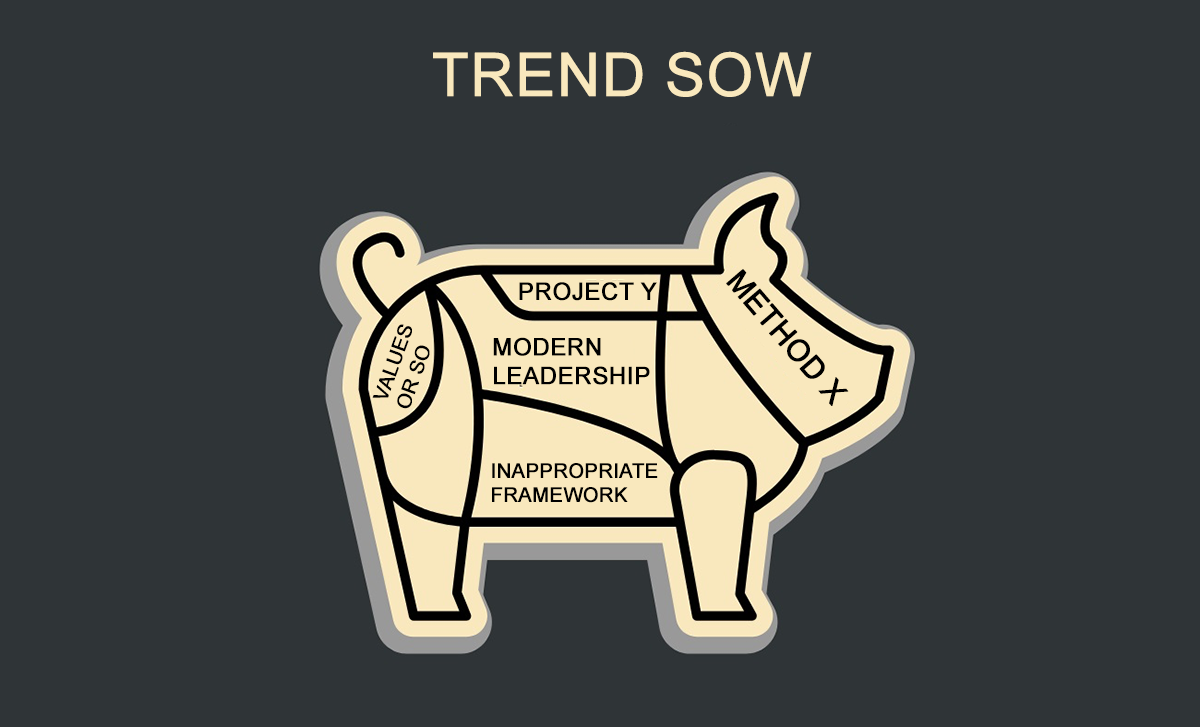The art of omitting things
“Would you like a little more?”
Perhaps you know this question from the meat trade? It is often asked by sales assistants to encourage customers to buy more goods or larger quantities. This is the situation that comes to mind when I think of changes in companies and the progress that is associated with them in the best case. Often more is offered, more is sold and more is bought than necessary. Why this is not the right way and what the art of omitting things is all about, you will now learn.
Trends, necessities or just nice-to-haves?
In our fast-moving world, striving for competitiveness and driving innovation is indispensable for almost every company. To this end, new ideas are constantly being collected and initiatives based on them are launched.
That sounds great at first: don’t wait long, get going quickly, and today’s organisation must be agile and adaptable.
This is exactly what has been suggested to us in recent years, among other things by influences such as the pandemic and the shortage of skilled workers.
Yes, it seems logical and exclusively advantageous to get into action quickly in order to see quick results. In the best case, by means of frameworks and predefined iterations that help to reflect through feedback loops whether what we are doing is actually still purposeful.
Much of this also seems to be attractive to customers and potential employees. One buzzword follows the next and yes, that can be an advantage, which I already mentioned in my article “Agility as a buzzword? – Yes please” here in the t2informatik Blog.
Surely you have also heard something about the “Fear of Missing Out” (FOMO) in the last few years. This is often associated with the use of social media. At the same time, FOMO also influences business life and can lead to companies starting more and more projects as well as collecting ideas without focusing on the essentials.
To be honest, it must also be said at this point that it is becoming increasingly difficult to distinguish between what is a necessity in today’s world and what is just chasing a fad. The sow that is being herded through the village and that colloquially indicates the short-livedness of a trend is felt to be omnipresent.
But what if the opposite were true? What if companies focused on omitting things and completing projects? A train of thought that I would now like to continue with you.
Why it is important to omit things
In addition to the actual completion of tasks and projects, the targeted omission of those is an absolute “game changer” that is often given too little attention.
Especially in change processes and transformations, it is about dropping old behavioural patterns and ways of working in order to create the space for something new in the first place. This is often equated with the familiar change of mindset.
If, on the other hand, we actually focus on the day-to-day business, the following list of reasons for omitting, among others, emerges:
- Focusing on the essentials
- Increasing efficiency and productivity
- Improving quality
- Avoiding waste (resources – people, costs)
- Less overload and stress
- Increased satisfaction
- Increased flexibility
Summary from an economic point of view: Money, quality, customer and staff satisfaction increase!
Pursuing too many projects at the same time can lead to an overload of resources and a lack of focus. The targeted omission of projects or activities in projects, on the other hand, can help the staff involved to concentrate on the most important tasks or projects, which often results in an increase in efficiency. And even if the often quoted idea is “done is better than perfect”, this does not mean that quality is put on the back burner; this often happens when a lot is done but little is done right.
Omitting things makes it possible to adapt more flexibly to changes in the business environment and to act more agilely accordingly. It seems almost paradoxical to have to mention this again, since the overarching goal is often precisely this desired flexibility.
In summary, it can be said that targeted omission – by concentrating on the essentials and the effective and efficient use of resources – helps to ensure success in the long term.
Challenges of omitting
On the one hand, we talk about becoming innovative and future-ready. On the other, the multitude of options can seem overwhelming. The openness to change coupled with the need to make targeted value-creating decisions can be challenging. It is already clear that this will not become easier in the future.
In addition to differentiating between necessity and nice-to-have, the challenge here is also that clinging to old habits impairs innovation and competitiveness.
What do I mean by a habit in this context, when the real issue is to do a lot but nothing right by constantly starting new projects?
Habit does get us to start projects, but it also often puts us back in the position of quickly turning our focus to new ideas when things get uncomfortable or fail to produce rapid results.
Habit is strongly influenced by individuals at this point. This is what each employee and decision-maker contributes in day-to-day business and operational implementation.
Furthermore, we live in a world in which we promote transparency through various media and technical possibilities. On the one hand, this is of course desirable from an interpersonal point of view, especially with a focus on values. On the other hand, however, this transparency also leads to providing a target for social expectations and the related handling of pressure.
Old habits and behaviour patterns, such as sticking to a wrong, already decided path and the urge not to miss anything afterwards, are thus in clear conflict with each other here. Openness and willingness to experiment, however, offers the chance to bring these two fronts together. Provided one overcomes existing fears and insecurities that also hold one back from these steps.
This is where the circle closes, because in a process of change, omitting things is often the first step. If we want to establish a new habit, we often have to let go of old habits.
How can omitting now be implemented?
We have clarified the why, the next and most practical step is to understand the how. I will list a few possibilities below, but I deliberately refrain from going into more detail at this point, as you will ultimately have to find out for yourself which “weirs” can best support you in targeted omission.
- Permanent alignment with overarching goals and challenges (cultural change, customer satisfaction, profitability).
+ Will what I plan to start contribute to achieving the overarching goal or will it rather slow it down? - Review of own activities and goals
+ Is what I am currently doing contributing to achieving my overall goal?
+ Is my goal still relevant or does it make sense to adjust it as well? - Renouncing unimportant activities and objects
+ What is actually important now? What is urgent? How do I see quick results in order to derive next steps promptly? Am I using the right tools?
Avoiding multitaskin
+ Doing the right things AND doing things right. - Mnemonics of the agile bubble
+”Simplicity – The Art of maximizing the work not done – is essential.” (Probably the most appropriate principle here, of the twelve agile principles).
+ Or as it is so beautifully called in the Kanban world: Stop starting, start finishing.
The solutions section seems very short, considering how big the challenges and the need to omit things seem. Rightly so, because as already mentioned, I believe that not every approach offers an obligatory solution for everyone.
Conclusion
Let me be quite frank, I do not absolve myself of having a great interest in innovations and trends. Especially when it comes to learning new things, I sometimes feel overwhelmed by information, possibilities and the vast amount of knowledge that is now available. Nevertheless, I have to admit to myself, and perhaps to you as well, that optimisations and adaptations also only work if we make conscious decisions and bring some paths to a conclusion in a targeted and high-quality manner.
If you look at the full scope, learn from it and derive future decisions, (and no, that doesn’t mean taking paths that you recognise early on are wrong) then bringing it to an end can also mean scrapping a project and taking new paths.
Take enough time to reflect. Even if it seems unproductive at first, the main purpose of reflection in the long run is to make better decisions. Sometimes a conscious no against something can also mean a yes for something else.
Would you like a little more? – No, not today. Thank you.
Notes:
If you like the post or want to discuss it, feel free to share it with your network.
Vanessa Steffen would like to encourage you to share your best practices:
- What has worked well for you when omitting?
- What can you share with us?
- What mistakes have you made and what can we learn from them?
For sure, Ms Steffen is looking forward to an interactive exchange. Because being stronger together never goes out of fashion!
Vanessa Steffen has published three more posts on the t2informatik Blog:

Vanessa Steffen
Vanessa Steffen founded Truelutions with the intention of supporting future-oriented companies in the field of agile organisational development and corporate management. In doing so, she brings together the needs of employees and employers while ensuring economic efficiency.
In the t2informatik Blog, we publish articles for people in organisations. For these people, we develop and modernise software. Pragmatic. ✔️ Personal. ✔️ Professional. ✔️ Click here to find out more.



